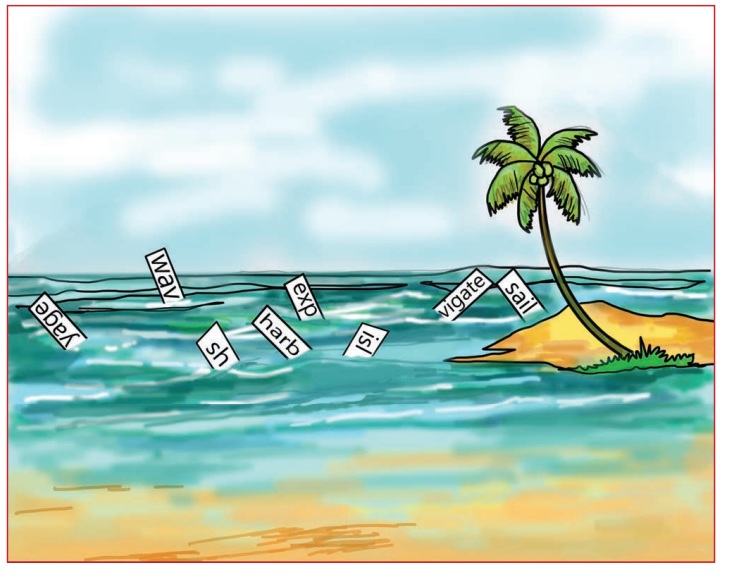English : Term 3 Unit 1 : Poem : Sea Fever
Warm Up
Rescue the sinking words!

1. Voyage
2. Waves
3. Island
4. Navigate
5. Sailor
6. Explore
7. Harbour
8. Shore
GLOSSARY
Star to steer– the north star is the pole star which tells the sailor where North is and thus they can steer the ship correctly
Flung – threw
spume – sea foam
vagrant -wandering
whetted -sharpened
yarn -A long or rambling story especially one that is impossible
flurried -worried
rover -wanderer
trick -a period of stay on the ship after the voyage
Poetic Devices
1. Simile :
It is a comparison made between two objects of different kinds which have some resemblance/ similarities. It is introduced by a word of comparison, such as, ‘like’, ‘as’.
Example:
Where the wind’s like a whetted life………. (Poem-1)
The wind is directly compared to whetted life, using the word like. So the figure of speech is Simile.
2. Metaphor :
It is a figure of speech that makes an implicit, implied, or hidden comparison between two things that are unrelated, but which share some common characteristics.
Example:
And quiet sleep and a sweet dream when the long tricks over. (Poem-1)
“When the long trick’s over”. The end of a long voyage is compared to the end of a long life. It is an indirect comparison, without using a word “like” or “as”. So, it is Metaphor.
3. Alliteration :
It is the repetition of identical initial consonant sounds at the beginning of two or more words in the same line.
Example:
…. to the lonely sea and the sky, (Poem-1)
sea – sky are the alliterated words.
4. Personification:
Personification is a figure of speech in which a thing – an idea or an animal – is given human attributes.
Example:
And the wheel’s kick and the wind’s song and the white sails shaking,…. (Poem-1)
The wind, the wheel and the white sail are given the human qualities. So, the figure of speech is Personification.
5. Imagery :
The descriptions create a picture in the reader’s mind.
Example:
And a grey mist on the seas face…….. (Poem-1)
This description creates a picture. So it is Imagery.
6. Rhyming :
It is making the last words in the lines produce the same sound.
7. Rhyme scheme:
A rhyme scheme is the pattern of rhymes at the end of each line of a poem or song. It is usually referred to by using letters to indicate which lines rhyme; lines designated with the same letter rhyme with each other.
Example:
Courage isn’t the last resort … (Poem-2)
In the work of life or the game of sport; … (Poem-2)
It isn’t a thing that a man can call… (Poem-2)
At some future time when he’s apt to fall; … (Poem-2)
Rhyming words: See the last word in each line, “resort-sport” and “call-fall”.
Rhyme Scheme: a a b b (It is based on the Rhyming words).
Questions Answers
A. Read the poem aloud in pairs.
B. Choose the best answer.
1. The title of the poem ‘Sea Fever’ means ______________________.
a) flu fever
b) the poet’s deep wish to be at sea
c) the poet’s fear of the sea
[Answer: (b) the poet’s deep wish to be at sea]
2. The poet asks for ___________________.
a) a fi shing net
b) a big boat
c) a tall ship
[Answer: (c) a tall ship ]
3. The poet wants to lead a life at sea like __________________.
a) the gulls and whales
b) the penguins and sharks
c) the pelicans and dolphins
[Answer: (a) the gulls and whales]
C. Read the lines and answer the questions.
1. I must go down to the sea again, to the lonely sea and the sky
Where does the poet want to go?
Answer: The poet wants to go to the sea again.
2. And the wheel’s kick and the winds song and the white sail’s shaking
What according to the poet are the pleasures of sailing?
Answer: Watching from the shore, the wind’s song, the ship’s steering wheel and the shaking of the sail in the breeze are the pleasures of sailing.
3. And all I ask is a windy day with the white clouds flying
Why does the poet ask for a windy day?
Answer: The poet asks for a windy day, as it would blow away the thick white clouds from the sky and take the sail forward throughout the day.
4. And all I ask is a merry yarn from a laughing fellow rover.
What kind of human company does the poet want?
Answer: The poet wants the company of a fellow sailor or wanderer like him.
5. And quiet sleep and a sweet dream when the long trick’s over
What does the poet want to do after his voyage is over?
Answer: The poet wants to sleep soundly with pleasant dreams at the end of his long shift on watch.
D. Poem Appreciation
1. Fill in the blanks with correct rhyming words from the poem.
sky____________, knife__________, rover____________
Answer: sky – by, knife – life, rover – over.
2. Quote the line that has been repeated in the poem.
Answer: “I must go down to the seas again”.
3. Write the poetic device which is used in the line below.
And a grey mist on the sea’s face ………………………
Answer: Imagery and personification.
3. What poetic device is used for the comparison in the below line?
………….where the wind’s like a whetted life:
Answer: Simile.
E. The poem has many visual and sound images. Complete the table with examples from the poem. The first one has been done for you.
Answer:
Visual images
Wheel’s kick
white sail’s shaking
grey dawn
running tide
white clouds flying
blown spume
sea-gulls crying
Sound images
Wind’s song
wild call
clear call
windy day














